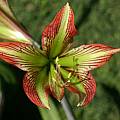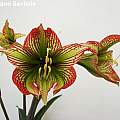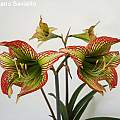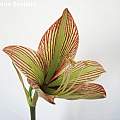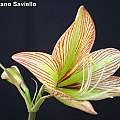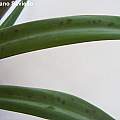Hippeastrum iguazuanum is a rare species within subgenus Omphalissa. It is native to the province of Misiones (Argentina) and the Department of Parana (Brazil). In Argentina it is reported in the departments of Guaraní, Iguazú, Oberá, San Ignacio and San Pedro. Bulbs were originally collected in Arroyo Central on way to Cabureí, growing among small rivers (Iguazú National Park, Department of Iguazú) and described in 1971 through this holotype by Piero Ravenna. Specimens found on route 101 beetwen Cataratas and Yaciú (Department of Paraná) and Lagoa Seca (Municipe of Paraíba), Brazil were designated as paratypes.
It is a winter deciduous species which flowers in early spring (September-October in the Southern Hemisphere) and grows in cliff faces with dense vegetation. It has interesting yellowish-green flowers with red veined and banded undulating tepals. This species can be easily grown as a pot plant or even in the ground in zones with Mediterranean climates (Zone 10, for example). It has beautiful glaucous leaves, which can be distinguished from those of H. teyucuarense, a very closely related species with distinct channeled leaves with the edges folded backwards. Some clones have a particular dark purple color in young leaves, although grown in shady conditions. It reproduces quite easily through lateral bulbs.
Williams and Dudley 1984 made chromosome counts using the acctocarmine technique for this species and reported that somatic chromosome number of 2n= 24 (or, expressed in other form, 2n=22 +BB), whereas the normal diploid number for most Hippeastrum species is usually 2n= 22. The "B" is a small chromosome fragment, and was suggested that the 12th chromosome pair in H. iguazuanum (also H. morelianum (2n=24; 22 + BB) and H. forgetii (2n=22+B) may have originated with this "B" fragment. In the segregation of B chromosomes in various crosses, the B chromosomes more commonly pass through the ova, rather than the pollen (H. pardinum crossed to a white H. hybridum, in "Segregation of the B chromosome" by Ising, G. (University of Lund, Sweden); Wide-Andersson, K. Herbertia 47:11-32).
The presence of a "B" chromosome was correlated with chromosome number and morphology, as well as with external morphological characteristics. Presence of a "B" was correlated with increased flowering frequency too, which could be evidenced in H. iguazuanum in the copious emission of flowers stalks simultaneously (photo 3 below) although interfering with fertility. Mariano Saviello finds that it is quite difficult to set seeds, even growing different clones of this species. According to this, B chromosomes are neither entirely beneficial nor harmful. They may interfere with fertility, but compensate by making the plants flower more often. There was also a correlation between "B" chromosome presence and spots; flowers tend to have more spots if "B" was present (H. pardinum, for example). Other species with a "B" chromosome includes H. blossfeldiae, H. calyptratum, H. striatum, H. forgetii and H. psittacinum. Furthermore, crosses of either H. iguazuanum or H. morelianum with a diploid (2N=22) species would yield aneuploid offsprings, which was confirmed by a colleague when crossing H. iguazuanum with H. leopoldii.
Photo 1 was taken by Germán Roitman. Photos 2-6 were taken by Mariano Saviello. Photo 2 shows details of the whole plant and the flowers with three flowers stalks growing simultaneously. Photos 3-4 show details of the beautiful yellowish-green flowers with red veined and banded undulating tepals. Photos 5-6 show details of a different clone, with smaller and less marked veined flowers. This clone is very similar to H. glaucescens and present no purple coloration in young leaves.
Photos 1-2 were taken by Mariano Saviello show the characteristic purple young leaves of some clones and the strange darker spots. Mariano does not really know why some purple leaf clones have this characteristic darker spots and some others do not, or even if this could be some kind of virus.
